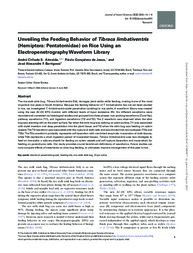Unveiling the feeding behavior of Tibraca limbativentris (Hemiptera: Pentatomidae) on rice using an electropenetrography waveform library.
Unveiling the feeding behavior of Tibraca limbativentris (Hemiptera: Pentatomidae) on rice using an electropenetrography waveform library.
Author(s): ALMEIDA, A. C. S.; JESUS, F. G. de; BARRIGOSSI, J. A. F.
Summary: The rice stalk stink bug, Tibraca limbativentris Stål, damages plant stalks while feeding, making it one of the most important rice pests in South America. Because the feeding behavior of T. limbativentris has not yet been studied in rice, we investigated T. limbativentris stylet penetration (probing) in rice stalks. A waveform library was created using the new AC-DC EPG monitor with different levels of input resistance (Ri). Six different waveforms were recorded and correlated via histological studies and grouped into three phases: non-probing waveforms (Z and Np), pathway waveforms (Tl1), and ingestion waveforms (Tl2 and Tl3). The Z waveform was observed when the stink bug was standing still on the plant surface, Np when the stink bug was walking on plant surface, Tl1 was associated with stylet insertion and deep penetration into the plant tissue, and Tl2 when the stink bug was feeding on xylem vessels. The Tl3 waveform was associated with the rupture of stalk cells and was divided into two subtypes (Tl3a and Tl3b). The Tl3a waveform probably represents cell laceration with combined enzymatic maceration of stalk tissues, while Tl3b represents a short ingestion period of macerated tissues. Tibraca limbativentris uses two strategies to feed on rice stalks: a salivary sheath for feeding on xylem vessels and cell rupture (laceration and maceration) for feeding on parenchyma cells. Our study provides crucial benchmark definitions of waveforms. Future studies can now compare effects of treatments on stink bug feeding, to ultimately improve management of this pest in rice.
Publication year: 2020
Types of publication: Journal article
Unit: Embrapa Rice & Beans
Observation
Some of Embrapa's publications are published as ePub files. To read them, use or download one of the following free software options to your computer or mobile device. Android: Google Play Books; IOS: iBooks; Windows and Linux: Calibre.
Access other publications
Access the Agricultural Research Database (BDPA) to consult Embrapa's full library collection and records.
Visit Embrapa Bookstore to purchase books and other publications sold by Embrapa.

